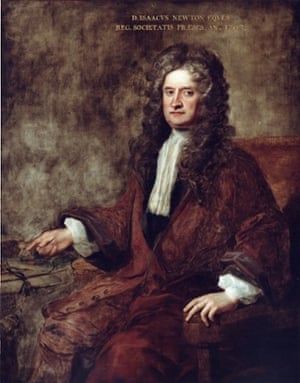Steven Weinberg: the 13 best science books for the general reader
The Nobel laureate on making science accessible – from Ptolemy to Darwin to Dawkins

If you had a chance to ask Aristotle what he thought of the idea of writing about physical science for general readers, he would not have understood what you meant. All of his own writing, on physics and astronomy as well as on politics and aesthetics, was accessible to any educated Greek of his time. This is not evidence so much of Aristotle’s skills as a writer, or of the excellence of Greek education, as it is of the primitive state of Hellenic physical science, which made no effective use of mathematics. It is mathematics above all that presents an obstacle to communication between professional scientists and the general educated public. The development of pure mathematics was already well under way in Aristotle’s day, but its use in science by Plato and the Pythagoreans had been childish, and Aristotle himself had little interest in the use of mathematics in science. He perceptively concluded from the appearance of the night sky at different latitudes that the Earth is a sphere, but he did not bother to use these observations (as could have been done) to calculate the size of our planet.
Physical science began seriously to benefit from mathematics only after Aristotle’s death in 322BC, when the vital centre of science moved from Athens to Alexandria. But the indispensable use of mathematics by Hellenistic physicists and astronomers began to get in the way of communication between scientists and the public. Looking over the surviving highly mathematical works of Aristarchus, Archimedes and Ptolemy, we can feel a twinge of sympathy for Greeks or Greek-speaking Romans who tried to keep up with the latest discoveries about light, fluids or the planets.
It was not long before writers called “commentators” began to try to fill this gap. Ironically, as writers they were so much more popular than professional scientists that in many cases it is their comments on scientific research rather than reports of the research itself that were copied and recopied, giving their books a chance to survive the collapse of the ancient world. For instance, we know about the measurement of the Earth’s circumference by Eratosthenes around 240BC not from his own writings, which are lost, but from the commentary of Cleomedes, writing several centuries later. It is as if in some post-apocalyptic future, scholars would learn about the work of Newton and Einstein from surviving articles in Scientific American or New Scientist.
After the fall of the Roman Empire in the west, the professional tradition of mathematical physics and astronomy petered out in the remaining Greek half of the empire, though it survived in the lands of Islam. This tradition was revived and reinvigorated in Europe in the late middle ages, reaching a climax two centuries later in the works of Kepler, Huygens, and, above all, of Newton. Newton’s Principia is still the most important book on physical science ever written, but it is forbiddingly difficult for any reader. Newton himself made no attempt to communicate his theories of motion and gravitation to general readers. It was thus important that Voltaire took it on himself to explain this work to the French public, who had been mired in the errors of Descartes. In 2006, in these pages, Ian McEwan rightly listed Voltaire’s Letters on England in a canon of science writing.
 As physical science became increasingly mathematical after Newton, communication with the public became more and more difficult. In the 20th century physicists George Gamow and Sir James Jeans took up the challenge of explaining the exciting new development of relativity and quantum mechanics, with mixed success. For me, just beginning in my teens to take a serious interest in physics, the books by Gamow and Jeans were inspiring. It was not that they made all clear. Rather the opposite. These books gave a vivid picture of a world governed by counter-intuitive fundamental laws, that (as Galileo had famously explained in The Assayer) could only be understood by someone who knew the language in which the laws were written, the language of mathematics. I remember seeing in one of their books (I think it was Jeans’s The Mysterious Universe) a discussion of Heisenberg’s uncertainty principle that mentioned the equation qp-pq=ih/2π. I didn’t know what was meant by the right side of the equation, but I knew that if q and p were any sort of number, then q times p would be the same as p times q, so how could qp minus pq be anything but zero? It was evident to me that I needed to learn a good deal before I could master this deep stuff.
As physical science became increasingly mathematical after Newton, communication with the public became more and more difficult. In the 20th century physicists George Gamow and Sir James Jeans took up the challenge of explaining the exciting new development of relativity and quantum mechanics, with mixed success. For me, just beginning in my teens to take a serious interest in physics, the books by Gamow and Jeans were inspiring. It was not that they made all clear. Rather the opposite. These books gave a vivid picture of a world governed by counter-intuitive fundamental laws, that (as Galileo had famously explained in The Assayer) could only be understood by someone who knew the language in which the laws were written, the language of mathematics. I remember seeing in one of their books (I think it was Jeans’s The Mysterious Universe) a discussion of Heisenberg’s uncertainty principle that mentioned the equation qp-pq=ih/2π. I didn’t know what was meant by the right side of the equation, but I knew that if q and p were any sort of number, then q times p would be the same as p times q, so how could qp minus pq be anything but zero? It was evident to me that I needed to learn a good deal before I could master this deep stuff.
So it isn’t always essential in writing about physics that everything should be made clear to the general reader. What is important is to respect readers, not to fool them into thinking that all would be clear if they were not such dolts, or that obscurity is a sign of profundity. In the preface of my book on the big bang, The First Three Minutes, I explained that “When a lawyer writes for the public, he assumes that they do not know Law French or the Rule Against Perpetuities, but he does not think the worse of them for that, and he does not condescend to them … I picture the reader as a smart old attorney, who does not speak my language, but who expects nonetheless to hear some convincing arguments before he makes up his mind.”
When working scientists like myself write for the public we have the opportunity to engage in controversy. The polemic mode of science writing goes back at least as far as the golden age of Muslim science, when it centred on the value of science and on its relation to Islam. One of the most accomplished of Muslim astronomers, the Persian al-Biruni, complained about anti-scientific attitudes among Islamic extremists, while the medical scientist Rhazes, who was admired by al-Biruni, argued that scientists are more useful to mankind than religious leaders and that miracles are mere tricks. In response, the famous physician Avicenna said that Rhazes should have stuck to matters he understood, such as boils and excrement.

Polemics also entered into the writing of European scientists for the public during the scientific revolution. Galileo not only disobeyed the orders of the Roman Inquisition when he argued in his Dialogo that it is the Sun and not the Earth that is at rest, he wrote the Dialogo in Italian rather than in the Latin of scholars, using little mathematics, so that it could be read and understood by any literate Italian. His countrymen were not unappreciative; by the time the church had suppressed the book, it had sold out.
Darwin’s On the Origin of Species is a nearly unique example of a report of professional scientific research of the highest calibre that at the same time is at least implicitly a polemic – as Darwin said, “one long argument” – on a public issue, the grounds of religious belief. He permanently demolished the nearly universal supposition that divine intervention is needed to explain the capabilities of plants and animals. His book works as a polemic in part because it is wonderfully readable. (Of course, Darwin as a writer had the advantage that biology in his time was not sufficiently advanced for the use of maths to be appropriate, so he didn’t have to face the task of explaining mathematical ideas to the public.) Polemics concerning science and religion continue to the present, notably in the writings of Richard Dawkins (also listed by McEwan in his canon) and Sam Harris on one side, and John Polkinghorne and Francis Collins on the other. I have had my own say about this issue.

Some years ago I began to write a good deal about another question: the public support of science. In the early 1980s, the US government backed plans to build a very large elementary particle accelerator, the Superconducting Super Collider. Work began, and about $1bn was spent, but continued funding remained in doubt. Along with other physicists, I was called on to explain to congressional committees, to editorial boards and to public meetings why the Super Collider was a good idea. I found myself so often defending the reductionist aims of high energy physics that I wrote a book about it, Dreams of a Final Theory. Alas, funding for the Super Collider was cancelled in 1983, but even though I grieve that we physicists had failed to convince Congress, I’m at least proud that my book made it into McEwan’s canon.
In recent decades another channel of communication of scientific ideas has opened to the public. It is literature. I am not referring to science fiction, which ever since Jules Verne has dealt with the impact of the technological applications of science. Lately some authors – Tom Stoppard, for instance – have become interested in the impact on individuals of the work of science and the ideas of science, rather than of its applications. They have done much to make science what some scientists have always hoped it would be: a part of the culture of our times.In To Explain the World I argue with those historians of science who try to judge each era’s scientific work according to the standards of that era rather than of our own, as if science were not cumulative and progressive, as if its history could be written like the history of fashion. One can recognise the great energy and intelligence of an Aristotle, while at the same time observing that his notion of how to learn about the world was an obstacle to progress. I have enormous respect for professional historians of science, from whom I have learned so much, but my book takes a cooler view than some historians do not only of Aristotle, but also of other icons such as Democritus, Plato, Avicenna, Grosseteste, Francis Bacon and Descartes.
That is indeed one aim that I think has prompted physicists such as Brian Greene, David Deutsch and Larry Krauss, and biologists such as Dawkins, Stephen Jay Gould and EO Wilson, to take time off from their own research to write for the general public. There are of course other aims. I think it was EM Forster who said that he wrote to earn the respect of those he respects, and to earn his bread. As to bread, I used to do a good deal of consulting on defence problems, until I learned that writing books was in every way more rewarding, and since it did not involve handling classified materials, I could do it at home. More important has been the opportunity of leaving for a while the ivory tower of theoretical physics research, and making contact with the world outside.
Steven Weinberg’s 13 best science books for the general reader
The list below is notably sparse in books by women. This is because women were not welcome in science through most of its history. Alexandria was less oppressive in this regard than Athens but, even so, of female natural philosophers from the ancient world, only Hypatia of Alexandria is prominent. Fortunately, however, slowly this flaw is being mended. Though still too few, there are now brilliant women in many branches of science, one of them included in this list.
Philosophical Letters (1733) VoltaireThe Origin of Species (1859) Charles DarwinOn a Piece of Chalk (1868) Thomas HuxleyThe Mysterious Universe (1930) James JeansThe Birth and Death of the Sun (1940) George GamowThe Character of Physical Law (1965) Richard FeynmanThe Elegant Universe (1999) Brian GreeneThe Selfish Gene (1976) Richard DawkinsThe Making of the Atomic Bomb (1986) Richard RhodesThe Inflationary Universe (1997) Alan GuthThe Whole Shebang (1997) Timothy FerrisHiding in the Mirror (2005) Lawrence KraussWarped Passages (2005) Lisa Randall
- To Explain the World is published by Allen Lane.
沒有留言:
張貼留言